Insightful newsletter of Drishtikone: Issue #318 - An Unending Betrayal of the Afghan
Afghanistan is a pot of extremism, death, evil and violence today. That is the result of decades and in some cases centuries of betrayals by different players. Let's check.
“To me, the thing that is worse than death is betrayal. You see, I could conceive death, but I could not conceive betrayal.” ― Malcolm X
Armageddon does not happen in a day. The pressures, the fissures, and the chipping away of the social structure keep adding up. When your home is a coveted real estate, for a mere passageway, then your value is diminished even further.
That is what has happened to Afghanistan.
As Pakistan's proxies in the Taliban take over Afghanistan, in most part with the support of the US establishment, the society there faces yet another existential crisis.
Far too many players have betrayed the common Afghan over the last so many years. A society that was once considered as the benchmark of integrity, has become a civilizational desert.
To understand the present, it is imperative to know the past. Why are we here? What caused it? Who were the players?
Unfortunately, we find some of the stories keep repeating themselves with almost the same scripts and even the players.
Operation Baikal-79: How Soviets started the slide
Aleksandr Silantjev, an 18-year-old from Narva, Estonia worked in a Baltijets factory in his hometown before he was forced to do military duty in December 1979.
On December 12, 1979, Soviet's biggest honchos - Head of the KGB, and later Brezhnev's successor, Yuri Andropov, defense minister Dmitry Ustinov and foreign minister Andrei Gromyko - met at Brezhnev's Dacha near Moscow.
The decision was to overturn Afghanistan's government and put someone they were comfortable with.
They group made the final decision to organize a coup in Afghanistan, which bordered the Soviet Union, to assassinate its leader, Amin, to install Kremlin loyalist Babrak Karmal in his stead, and to deploy close to 100,000 troops, known as the 40th Army, in the country. (Source)
The whole operation was known as Operation Baikal-79. Its most sinister and potent component was Operation Storm-333, also known as the Tajbeg Palace Assault. (Source)
Date: December 27, 1979
Goal: to assassinate People's Democratic Party General Secretary Hafizullah Amin and take over Kabul.
The operation to seize about 20 key objects of the Afghan capital was named "Baikal-79". Soviet special forces were supposed to attack, in particular, the General Staff and the Ministry of Defense, the headquarters of the military counterintelligence, the Central Telegraph, prisons for political prisoners, as well as the television center. One of the targets was the Taj Bek Palace, better known as Amin's Palace. The assault on this fortified complex was named "Storm-333" and was entrusted to the "Thunder" group and the soldiers of the special forces detachment of the First Main Directorate of the KGB of the USSR "Zenith". Special forces fighters arrived in Kabul gradually, settling in villas in the city limits. "I flew to Kabul in October 1979. The first task was to strengthen the security of the embassy, in addition, the operatives studied the capital of Afghanistan," a participant in the assault tells TASS. (Source)
500 special forces commandos comprising KGB special groups - 25 men from a unit of Alpha Group’s "Grom", 30 operators from a special KGB group Зенит "Zenit", the GRU, and 87 conscripts from Lt, Vostrotin's 9th parade of paratroopers from 345th Independent Guards Airborne Regiment) launched Operation Storm 333.
Run up to Operation Storm-333
The Soviet-Afghan border was heating up in the late 1970s.
Sardar Mohammed Daoud Khan, ex-Prime Minister (1953-1963) led a coup d'état in 1973 to overthrow the monarchy and became the first President of Afghanistan. Khan was born into the Afghan Royal family. He was the cousin of King Mohammad Zahir Shah, who had made him the commander and later the Prime Minister. In 1973, with the backing of Afghan Army officers, Doud Khan took the reigns of Afghanistan in his hands.
He went on to purge communists from Afghanistan.
In April 1978, the Saur Revolution or Sowr Revolution (Sowr is the second month of the Solar Hijri calendar in Afghan Language Dari) also called April Revolution or April Coup was carried out and President Doud was assassinated. Nur Muhammad Taraki was installed as the President and the General Secretary of the Revolutionary Council. Taraki did not last long either.
The murder of a leading Afghan Communist Party leader in early April 1978 may have encouraged the communists to launch their successful campaign against the Daoud regime later that month. In the political chaos that followed the death of Daoud, Nur Mohammed Taraki, head of the Afghan Communist Party, took over the presidency. In December 1978, Afghanistan signed a 20-year “friendship treaty” with the Soviet Union, by which increasing amounts of Russian military and economic assistance flowed into the country. None of this, however, could stabilize the Taraki government. His dictatorial style and his decision to turn Afghanistan into a one-party state alienated many people. In September 1979, Taraki was himself overthrown and murdered. (Source)
Taraki’s end came at the hands of his own protege - Hafizullah Amin.
Amin was one of the main organizers of the Saur Revolution and a close associate of Taraki until they started having differences resulting finally in that sad death of Nur Muhammad Taraki.
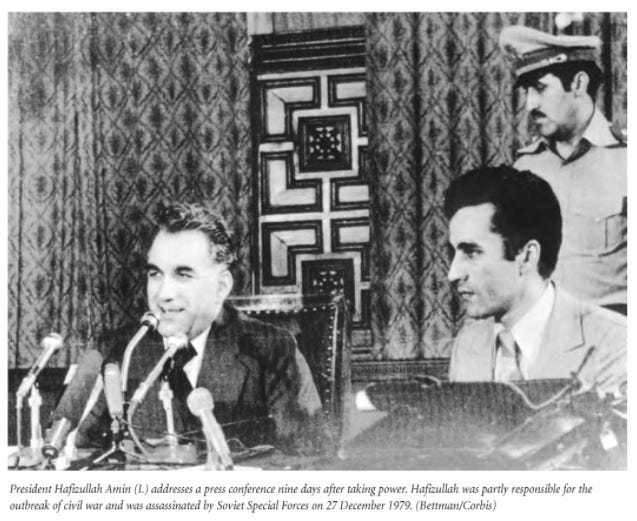
Amin’s regime was brutal and many executions were done in his time.
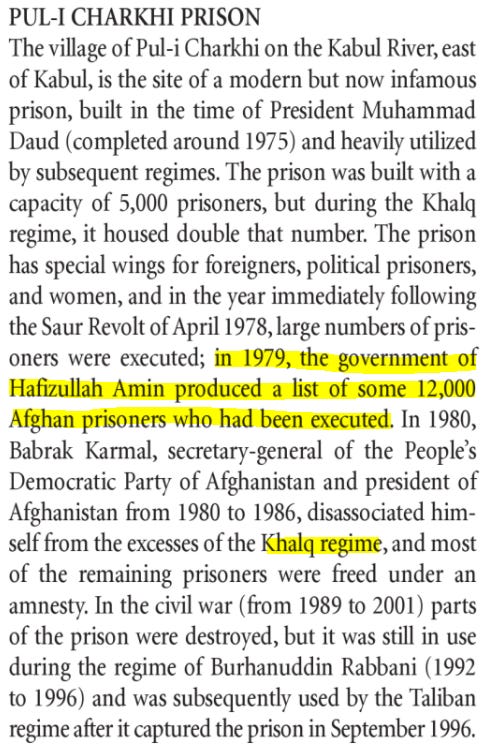
It is said that between 1978 and 1979, over 27,000 prisoners – mainly Mullahs and Headmen – were executed in Pul-e-Charkhi prison!
On that day of Operation Storm-333, the Soviets also lost 14 (5 KGB, 7 troopers of Muslim Battalion, and 2 paratroopers) of its people. The commander of the KGB contingent, Col. Boyarinov was also killed. Even the Soviet army doctor Colonel V.P. Kuznechenkov, who was attending to President Amin (for his food poisoning) was killed as well.
Post Operation Storm-333, the Soviets installed Babrak Kamal, the exiled leader of the Parcham faction of the Marxist People’s Democratic Party of Afghanistan (PDPA), as the new President.
Kamal was not a very popular leader. With the Soviet military behind him, his presence was a deeply hated one.
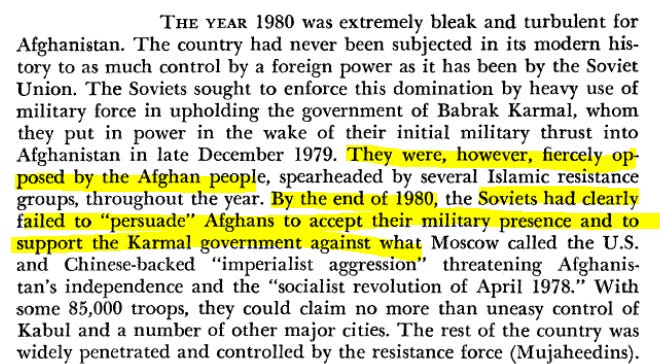
However, the initial resistance to Soviets by the Afghan groups, many of whom were tribal and ethnic, was led by several secular and nationalist Afghan groups who were opposed to the Soviet-backed Communists.
These initial Mujahideens were nationalist or rather fighting for their collective identity, despite their tribal/ethnic differences.
What is the Afghan state?
One needs to understand Afghanistan. It was brought together under dynastic rule in 1747 as a sort of tribal confederation. Some say that there never has been an Afghan nation (like Oliver Roy does in his book “Islam and Resistance in Afghanistan”). There have been ethnic and family rules running relatively autonomous regions with their own rules. Central power was not really much of a concept, nor appreciated.
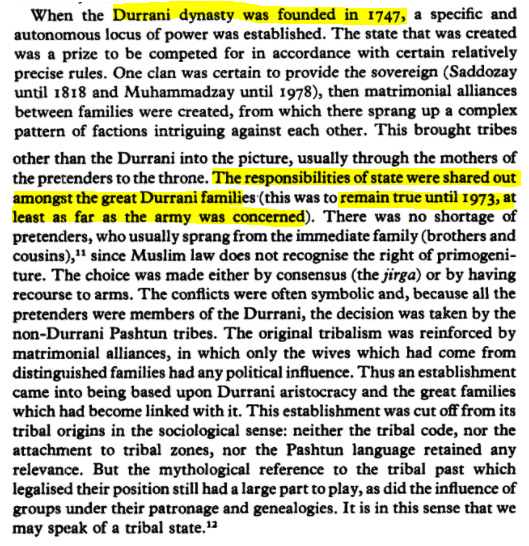
This aversion to central rule and independence in the family and ethnic ties is what really defined the power structures in Afghanistan.
It was amidst this large cauldron of different ethnicities and familial ties that an Islamic identity was being laid upon the Afghan society by Pakistan and Saudi Arabia.
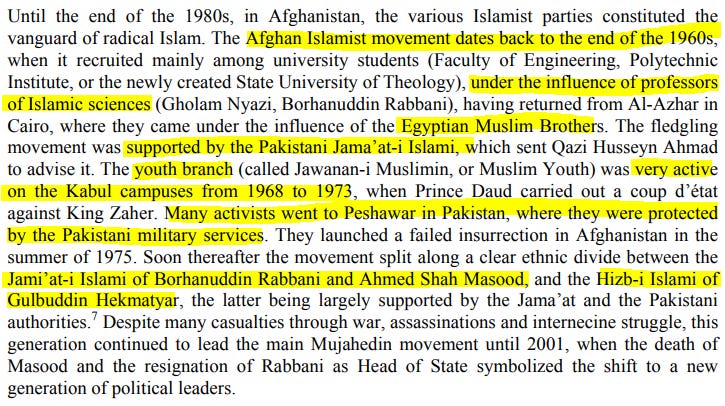
The Opportunism of Islamic Jihad: Why Pakistan?
Pakistan had baggage with respect to its relationship with Afghanistan. It is a little-known fact that after the Independence and Partition of Pakistan, the only Government to oppose the entry of Pakistan into the United Nations was Afghanistan.
In July of 1949, the Afghan Government even rescinded all the agreements they had with the British Government with respect to the Durand line. For many years, it is suggested that the Afghan Government even encouraged the secessionist movement in Pakistan for the Pashtuns of NWFP.
It was Zulfiqar Ali Bhutto who turned the tide on the Pashtuns. He not only cracked down on the Baloch and Pashtun Nationalists, he also came up with the idea of supporting an Islamist movement in Afghanistan against the People’s Democratic Party of Afghanistan (PDPA) Government, which was backed by the Soviets. Brig. Naseerullah Babar (also the home minister in Benazir Bhutto's government) had set up a secret military-training program for the Afghan students near Peshawar with the approval of ZA Bhutto.
"I told the government we must have some elements to influence events in Afghanistan in case there was trouble," Babar later explained. "We took them under our wing and started giving them small-arms and specialized training." It was a watershed decision: a first step in a steady shift toward what the British had euphemistically dubbed "forward policy" -- direct intervention in Afghan politics. (Source: CNN)
A policy by Pakistan that would devastate Afghan, the subcontinent region, Pakistan and the rest of the world.
Islamic Jihad and entry of the Lion
The real story of Soviet expulsion from Afghanistan and the overthrow of the Communists in that country was written by a bright young man who could speak several languages: Persian (Farsi), Pashto, Urdu and Hindi along with French and Arabic.
His name was Ahmad Shah Massoud.
As early as 1972, he became involved in sazman-i jawanan-i musulman (“organization of Muslim youth”), which was the student branch of the Jamiat Islami (“Islamic Society”).
The organization was led by Burhanuddin Rabbani. In July 1975, an upcoming Jamiat member Gulbuddin Hekmatyar organized an uprising against Daoud Khan. Ahmad Massoud led the fight in Panjshir. Gulbudin and Massoud lost. The local people did not help them. In 1976, Rabbani and Hekmatyar parted ways as Hekmatyar became more fundamentalist. Massoud joined Rabbani.
Ahmed Shah Massoud: How powerful events shaped his life
Ahmed Shah was born in Bazarak, the capital of the Panjshir province in the Panjshir Valley of Afghanistan. He took on the nom de guerre of Massoud in 1974 when he joined the resistance movement.
Massoud was the third of six sons born to a well-to-do Tajik family and his father Dost Mohammad Khan was a colonel in the Royal Afghan Army. He studied in Lycée Esteqlal a Franco-Afghan High School in Kabul, followed by Engineering at Kabul University.
Massoud was among those who went to the Cherat Army Camp near Peshawar that had been set up by Brig. Naseerullah Babar to train the Afghan youth.
Alongwith a number of Ikhwani members, Ahmed Shah and Gulbuddin Hekmatyar formed a new political party named “Hezb-i-Islami.” (Party of Islam). In Kabul, this group was known as the “Muslim Youth.”
Massoud’s instructors comprised of Pakistan’s elite Special Service Group. This group trained Massoud and his friends who were dressed in the Frontier Corps uniform (Babar’s Corp).
Moderate, not Islamist
Despite being aligned with the Jami’at, Ahmed Shah Massoud had little love for the ideological extremism of Jami’at. His concern was to get the support of the local mullahs and ulama so he could create a movement that had a broad base.
Engineer Ishaq, one of Massoud’s close associates, once said in the statement “Islamic Government: Clarifying Some Confusions”, in Afghannews (August 15, 1987)
“Islam does not present a blue-print for an Islamic government."
The idea of this communique was to keep the movement away from Islamism.
Amongst the mujahideen trained by Pakistan (Babar’s camps), one guy took over the reins of the movement against the Soviets very quickly - Gulbuddin Hekmatyar. He overshadowed the Tajik theology professor Burhanuddin Rabbani.
Big turning points in Massoud’s life
In July 1975, Islamic fighters backed by Pakistani intelligence went after Doud’s government in Panjshir valley. Massoud went in with the hope that the locals would back them.
Instead in a tragi-comedy, the locals chased the mujahideen to the higher reaches of Panjshir.
Within six months, the Islamist movement was overtaken by a series of events that left deep emotional scars on Massoud and permanently blighted his perceptions of Pakistan. In late July 1975, ISI pressure sent the young Afghans into eastern Afghanistan for a wave of attacks on government offices. "I told Mr. Bhutto it is time we conveyed a message to Daoud," said Babar, who later recalled the operation as a success. But for the young Afghans, the result was a debacle. Massoud himself led over 30 students to his native Panjshir valley in the naive hope the population would rise against Daoud. But even before government commandos were helicoptered into the valley the next day, the local populace had chased the revolutionaries into the mountains. It was a tragi-comedy that left nearly half of Massoud's comrades dead or arrested, and it was followed by a brutal crackdown on other suspect Islamists by an unnerved Daoud. (Source)
Massoud lost almost half his men and had to fight his way out in a desperate situation.
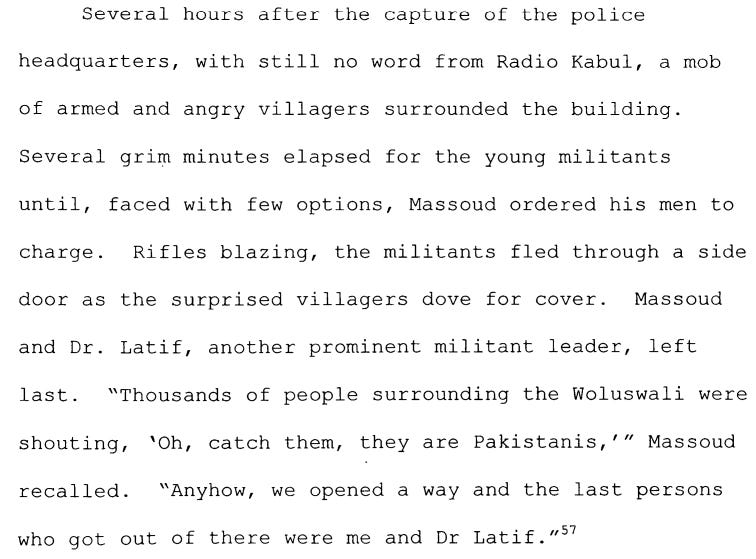
This was the first major turning point in Massoud’s life.
After this Ahmed Shah went back to Pakistan to meet the Afghan community living in exile there. Rabbani was leading the most gradualist part of Jami’at, while Pakistanis had found their leader in Gulbuddin Hekmatyar. Hekmatyar wanted “armed struggle.”
This split the movement into two factions - Massoud went with Rabbani. As Massoud would later say -
"Pakistan took Hekmatyar's side completely, and we became the opposition!" (Source)
In 1977, the Pakistani intelligence decided on purging the anti-Gulbuddin faction. Ahmed Shah Massoud’s close friend, Jan Mohammad was amongst the first one to picked up by the ISI. He was tortured and killed by the ISI.
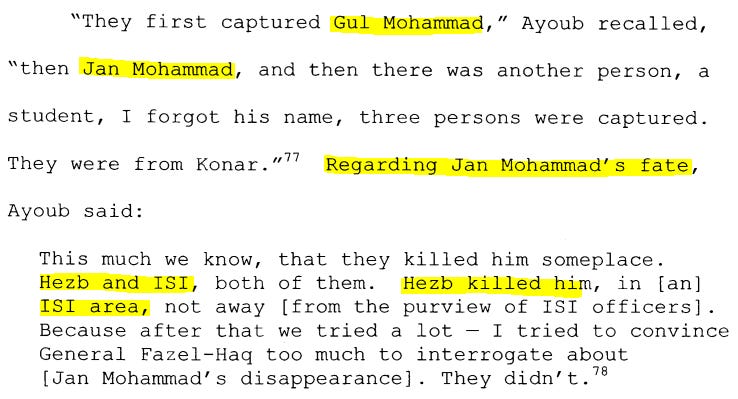
Based on confessions by Jan Mohammad, Ahmed Shah Massoud was arrested by Hezb’s deputy leader Qazi Amin and an ISI agent from the house of the governor of North-West Frontier Province. He was freed because of a senior Jami’at leader Ayoub, who arrived at the nick of the moment.
This was the second point that Ahmed Shah Massoud never forgot nor forgave. He nearly died betrayed by a close friend and his ex-allies and mentors.
Finally, in the spring of 1979, Massoud and his men trekked all the way to Panjshir valley. Amin was the President and hatred for the Communists and Soviets at its peak.
"As we moved down the valley a flood of people were streaming behind us -- white-beards, kids, mullahs carrying spades, scythes and guns," he recalls. "I could hardly believe my eyes." The torrent of anger swept down the valley and spilled onto the highway leading to the Salang valley where ensuing battles with government troops left Massoud with a bullet in the leg. By year's end when the Soviets intervened to rescue a tottering Communist revolution, Massoud already controlled the Panjshir. (Source)
The time from 1980 through 1984 was a period of strong Soviet offensives and fight back by Ahmed Shah Massoud’s forces.
Soviet attacks and Evolution of Massoud
Massoud was evolving from a guerilla fighter to a builder of an Army.
To further affirm and legitimise his authority, Massoud engaged in considerable propaganda efforts, starting very early on with inscribing anti-Soviet slogans on rocks and publishing newspapers that were used by mullahs in their Friday prayers. This legitimisation strategy is not uncommon in civil wars. ‘By portraying the enemy, be it the state or another armed group, as particularly brutal, inhuman and evil’, write Schlichte and Schneckener, ‘the armed group aims not only to create solidarity but also to present itself and its violent actions as necessary, appropriate and comparatively less destructive’. In 1980, a dawat-e Jihad (invitation to holy war), a non-military governing body, was created alongside every military base under Massoud’s control. These bodies were in charge of recruiting young mujahideen, engaging in propaganda efforts, printing newspapers, running radio channels and educating children and cadres to the necessity of Jihad against the Soviet Union, hence building a common symbolic repertoire to ‘bring together the disparate agendas at the local level with the central cleavage’. Classes for the educated elites were organised around disciplines such as international politics and Islamic ideology. Massoud, a fervent reader of Mao, Che Guevara and others, even taught a class on guerrilla warfare. (Source)
Massoud followed a four-phase plan to entrench himself and throw the Soviets out.
Establish a popular resistance movement with backing from people
Active Defense of the Panjshir Valley and an asymmetric warfare strategy against the Soviets
Strategic Offensive, where the forces would move to get control of Northern Afghanistan
Lastly, repeat it all in entire Afghanistan and defeat the communist government
The Salang Pass and the Panjshir valley were the path that Soviets took to send supplies, tanks, ammunitions to their forces in Afghanistan. Massoud, once he had strengthened his positions in Panjshir used it to launch ambushes against the Soviet convoys.
Known as the Lion of Panjshir, Massoud has established a local political and judicial system, organized his own tax system, instituted classes in the use of rocket launchers and heavy artillery, and even set up schools and bus services throughout the valley. His Mujahedin have also hounded their Soviet invaders. Recently they captured and reportedly killed 23 Soviet agents disguised as Mujahedin. By persistently ambushing military convoys traveling between Kabul and the Soviet border, they have caused a severe fuel problem in the capital, a mere 40 miles to the south. Only two weeks ago they compounded that shortage by blowing up four strategically vital bridges. Small wonder, then, that the Soviets have shattered their 13-month truce with Massoud and mounted their fiercest attack since the invasion of Afghanistan in December 1979. (Source: Time)
IN 1984, the Soviets launched a major offensive against Massoud’s men in Panjshir.
As many as 100 Soviet Tu-16 Badger bombers and Su-24 Fencer fighters saturated the area with high-altitude carpet bombing. In their wake came some 80 Mi-24 Hind assault helicopters, more than 500 tanks and armored personnel carriers and, according to Western diplomats, more than 20,000 troops, almost a fifth of the entire Soviet force in Afghanistan. (Source: Time)
Massoud would respond back by having deep connections in the Afghan Army who would warn him in time.
The Soviet Union reacted to Massoud’s attacks by launching six consecutive assaults on the Panjshir valley between 1980 and 1982, but could never defeat Massoud, although he only commanded over roughly one thousand fighters at the time of the first assault. Thanks to Massoud’s intelligence networks in the Afghan Army, his forces were able to disappear and hide in the mountains before aerial bombings began, to later suddenly reappear and surprise Soviet tanks entering the Panjshir. By targeting the first and last tanks going through the narrow valley, Massoud’s forces were able to stop entire columns, forcing the Soviets to abandon their tanks to the enemy. (Source)
Salang Pass took on legendary status for the Soviet soldiers. Such was the force of Massoud’s guerilla warfare. Heck, drivers who would successfully cross-over would get official recognition and awards.
A successful trip from the Soviet border to Kabul became an event to be commemorated and remains so. One 1985 Soviet article described a young soldier's experience this way: Igor Chernega, still a private at the time, painted the first small star on the cab of his KamAZ truck a year and a half ago. On that December evening, he was a soldier full of pride. He had withstood the Salang's baptism with dignity, although that two-week trip demanded fortitude, perseverance, stoic patience and human courage such as he had not even suspected he had within him.
While this kind of prose may seem a bit overdrawn, every indication is that Soviet motor transport drivers perform one of the most dangerous and harrowing duties in Afghanistan. Official recognition of this is reflected in the Soviet practice of awarding pennants inscribed "For Courage and Valor" after every 20, 40, 60 or 80 trips. As noted, the drivers themselves paint a star on the side of their truck cabs for each successful trip. As of September 1985, 80 trips was the maximum that could be completed in a twoyear term of service, a Soviet-cited limit that is apparently a consequence of the time required to make the hazardous journey. (Source)
After years of losses and defeat, the Soviets finally left Afghanistan. The final and complete withdrawal of Soviet combatant forces from Afghanistan began on 15 May 1988 and ended on 15 February 1989 under the leadership of Colonel-General Boris Gromov.
Post-Soviet Era in Afghanistan
The forces of Najibullah and PDPA held their own for three long years, performing better than under the Soviets. The Soviets backed the communist regime of Najibullah until December 1990. After that very few sympathetic people were in power. The Soviet Union was dissolved on December 26th, 1991. That was the end of all support for Najib’s government. In January 1992, all support to Afghanistan was shut down. The impact was immediate and direct. There was no fuel for the Air Force. In April 1992, Najib tried to flee to the UN compound and then seek asylum in India. He was stopped by troops of Abdul Rashid Dostum, once his commander who had now joined together with Ahmed Shah Massoud.
The last communist president of Afghanistan had only a radio and television to drown out the sounds of the civil war raging around him. As fighting for control of the nation raged on, Najibullah busied himself translating Peter Hopkirk’s The Great Game into Pashto. From 1992-96, Najibullah remained in a United Nations compound, waiting for the UN to negotiate his safe passage to India. But leaders of various factions fighting for control of the country demanded he be handed over for trial. (Source)
Senior communist generals and officials of the Najibullah administration subsequently transferred the power to Ahmed Shah Massoud’s alliance. By then, Ahmed Shah Massoud had grown very far apart from the Pakistani establishment.
By the final fall of President Najibullah's Communist regime in 1992, the rift between Massoud -- by then commanding a small army of some 8,000 -- and the Pakistani military was dangerously wide. In October 1990, a visit to Islamabad by Massoud, his first since the spring of 1979, produced meetings with Pakistan's then-chief of Army Staff Gen. Aslam Beg and ISI chief Lt.-Gen. Assad Durrani. But attempts to paper over the gulf were too little and too late. (Source)
By end of April 1992, Kabul was in the hands of Rabbani and Massoud.
After Moscow’s supplies to the Afghan communist regime got cut off with the collapse of the Soviet Union in December 1991, Massoud started approaching the most powerful pro-government commanders of the North to plan the capture of Kabul and the ensuing power-sharing arrangements. Massoud was designated to become the future defence minister through the Peshawar accord, a power-sharing agreement signed by the main political leaders exiled in Pakistan on 24 April 1992, the day before he and his northern allies took control of the capital. Starting in 1992, Massoud and Rabbani (who would become President of the Islamic State of Afghanistan a few months later) therefore controlled the most important buildings in Kabul. (Source)
Massoud wanted a broad-based government.
“All the parties had participated in the war, in jihad in Afghanistan, so they had to have their share in the government, and in the formation of the government. Afghanistan is made up of different nationalities. We were worried about a national conflict between different tribes and different nationalities. In order to give everybody their own rights and also to avoid bloodshed in Kabul, we left the word to the parties so they should decide about the country as a whole. We talked about it for a temporary stage and then after that the ground should be prepared for a general election.” (Source: Neamatollah Nojumi. The Rise of the Taliban in Afghanistan: Mass Mobilization, Civil War, and the Future of the Region (2002 1st ed.). New York: Palgrave. p. 112)
Massoud talked to Hekmatyar over the radio to pave the way for the Peshawar Accord. Hekmatyar’s unfortunate response was “We will march into Kabul with our naked sword. No one can stop us. ... Why should we meet the leaders?"
On April 24, 1992, however, the Peshawar Accord was signed and a new government with Massoud as the Defense Minister was formed.
A Peace agreement was also signed between Hekmatyar and Massoud on 25 May 1992, which made the former Prime Minister. The agreement, however, did not survive when Hekmatyar was blamed for a rocket attack on President Mojaddedi's plane.
Abdul Rashid Dostum's Jumbish forces joined hands with Rabbani and Massoud’s Jamiat forces against Hekmatyar's Hezb-i Islami forces.
That started a period of internecine Afghan wars and battles that destroyed most of Kabul and Afghanistan. Hekmatyar and his fetish to target the civilian areas meant huge casualties. All because he wanted to establish the “true Islamic Republic”.
Pakistan phases out the old - with Taliban
By 1994, however, The Pakistanis had lost all patience with Hekmatyar because he could not deliver on the promise of uniting the Pashtuns.
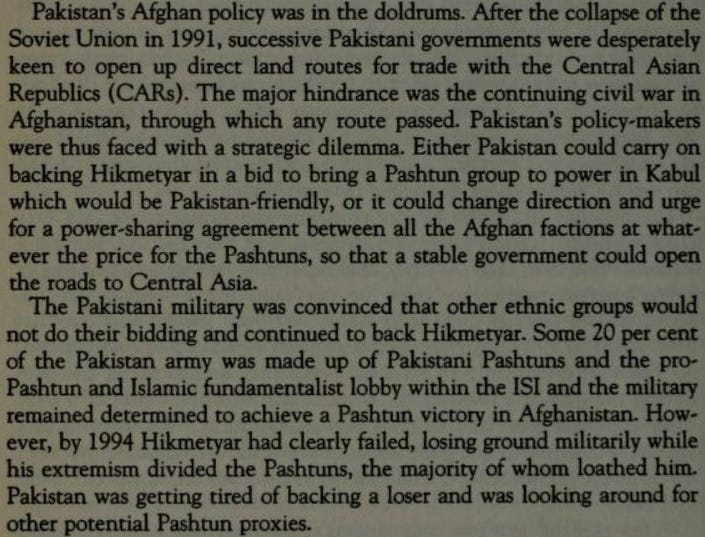
The stage was set for the Taliban to now emerge.
On October 29, 1994, a convoy from Pakistan Army’s National Logistics Cell (NLC) left Quetta with 80 Pakistani ex-army drivers. A group of local commanders, including Mansur Achakzai, stopped and held the convoy near the Kandahar airport.
On November 3rd, the Taliban moved in and not just killed them but hung Mansur’s body for all to see.
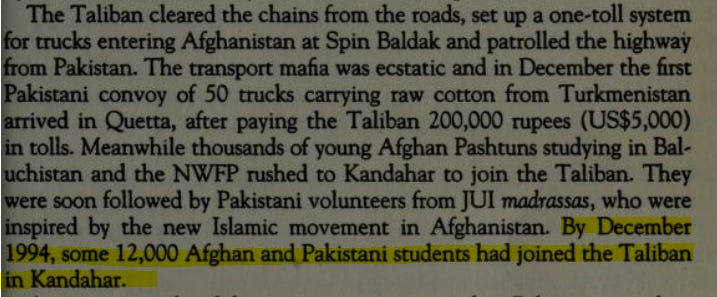
In 1995, the Taliban started bombardment of Kabul, which was repulsed by Massoud’s forces. By February 1996, different factions were joining hands in a peace process. A possibility that scared the Pakistanis. It was decided that they needed to act quickly. Backed by Pakistan’s Army and funded by Saudi Arabia, the Taliban launched an offensive in Jalalabad. This opened Kabul up to a complete assault from all sides. Massoud decided that it was time to retreat.
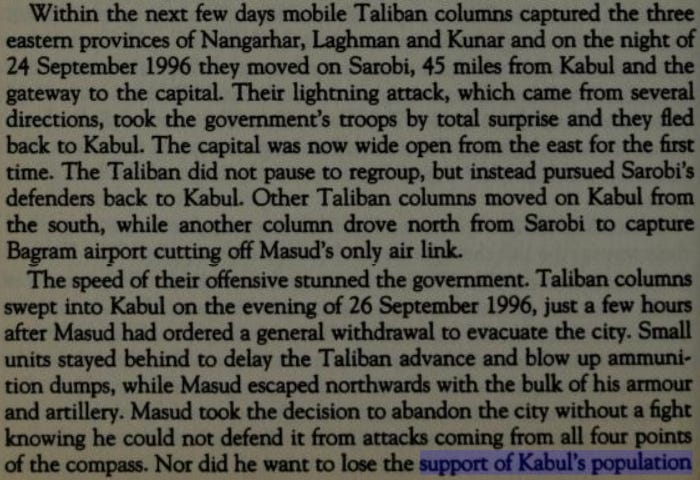
On the afternoon of September 26th, 1996, the Taliban walked into the UN compound, then guarded by two frightened Afghan guards who abandoned on hearing Taliban guns, and beat up ex-President Najibullah and took him to the Presidential Palace, castrated him and shot him and his brother dead and hung them up from the traffic control post.
The next five years until September 2001, Massoud was the only front against the Taliban in Afghanistan, specifically after the fall of Dostum at Mazar-i-Sharif in 1998.
From 1999, Ahmed Shah Massoud worked hard to bring the different ethnicities together in an effort to create a broad-based Afghan government.
'Lion of Kabul' (Abdul Haq), the 'Lion of Panjshir' (Ahmad Shah Massoud), senior Hazara and Uzbek leaders, Hamid Karzai, and even exiled King Zahir Shah in Rome were willing to work together. Pashtuns, Tajiks, Uzbeks, Hazara could have finally been together for Afghanistan.
Massoud with leaders from all ethnicities of Afghanistan addressed the European Parliament in Strasbourg on April 5, 2001
He told them that the international community needs to provide support to the anti-Taliban forces which are being backed by Pakistan, and Osama Bin Laden.
It was on this trip that he warned of something big to come if something happened to him.
On September 9, 2001 - three suicide killers, claiming to be Belgians originally from Morocco - names Dahmane Abd al-Sattar, husband of Malika El Aroud, and Bouraoui el-Ouaer; or 34-year-old Karim Touzani and 26-year-old Kacem Bakkali - assassinated Massoud on the pretext of an interview.
The man who had escaped attempts on his life by al-Qaeda, the Taliban, the Pakistani ISI, Soviet KGB, the Afghan communist KHAD, and Hekmatyar - finally lost his life at the hands of Pakistan-backed suicide mission.
A legacy that he left is now being carried on by his son, Ahmed Massoud and protege Amrullah Saleh.
market corner: 10 quick bytes
Amazon, Microsoft swoop in on India's $24 billion farming data trove (Source)
Telecom industry revival package: Telcos get cash flow boost as Cabinet clears relief package (Source)
Apna acquires unicorn status after $100 mn fundraise led by Tiger Global (Source)
LIC IPO: Govt seeks $109 bn valuation for state insurer's mega public offer (Source)
Indian stock market overtakes France; becomes sixth-biggest (Source)
TCS first Indian tech company to cross $200 billion market cap (Source)
Auto sector, drone PLIs: Green light for new-age tech (Source)
IT dept alleges Sonu Sood, associates evaded Rs 20 crores tax, violated FCRA (Source)
Cabinet clears Rs 25,938 crore PLI scheme: Boost to EVs, hydrogen fuel cell vehicle manufacturing (Source)
Indian saffron's international prices skyrocket after Afghan supply hit by Taliban takeover (Source)
nota bene
World’s largest Expressway: Union Minister for Road Transport and Highways, Nitin Gadkari on Friday announced that the government is constructing the world's longest highway, that is, Delhi-Mumbai Express Highway. Speaking at the event, Gadkari said, "The Expressway will be 1,380 km long and will go up to Jawaharlal Nehru Port Trust (JNPT), But now, we are also planning to take it up to Nariman Point." (Source)
Nuke subs for Australia: US President Joe Biden, British Prime Minister Boris Johnson and Australian Prime Minister Scott Morrison appeared together virtually to detail the new alliance, which will be called AUKUS (pronounced AWK-us). The three announced they would quickly turn their attention to developing nuclear-powered (Source)
Delhi Terror Plans: A team of Maharashtra Anti-Terrorist Squad (ATS) and Special Cell of the Delhi Police is jointly interrogating the six terror suspects who were planning to carry out attacks in the forthcoming festival season, an official said here on Thursday. It has been revealed during questioning that the Pakistan-sponsored terror module arrested by the Delhi Police was planning to repeat a 1993 Bombay blast-like attack, reports India Today. They further revealed that they had identified multiple locations for the same. Furthermore, about 1.5 kg of RDX has been recovered from the arrested terrorists.
Brahmaputra Ropeway Project: Longest river ropeway project in India completes one year; receives 50,000 visitors. Passenger ropeway project by DRIL across Brahmaputra river is 1800m long connecting South to North Guwahati. The iconic construction marvel and the longest river passenger ropeway with supporting towers deep inside the mighty Brahmaputra River have completed its one year of operation recently. The construction work on the project was started and taken forward during the time of the pandemic, with around 10 engineers and 40+ skilled laborers. The company during the completion of the project faced plenty of challenges in the transportation of heavy materials (weighing close to 25-40 tons) across the turbulent river. (Source)
Facebook knew of its harms yet buried them: Facebook knew that teen girls on Instagram reported in large numbers that the app was hurting their body image and mental health. It knew that its content moderation systems suffered from an indefensible double standard in which celebrities were treated far differently than the average user. It knew that a 2018 change to its news feed software, intended to promote “meaningful interactions,” ended up promoting outrageous and divisive political content. Facebook knew all of those things because they were findings from its own internal research teams. But it didn’t tell anyone. In some cases, its executives even made public statements at odds with the findings. (Source)
Milk created Migration: The Great Bronze Age migration was fuelled by MILK! Adoption of dairy into the diet gave European populations the mobility to sweep east as far as Mongolia 5,000 years ago, study finds. Mass migration of people went east and west from Russia at the dawn of the Bronze Age. They then introduced new languages and technologies such as wheeled wagons. Researchers studied the teeth of 56 individuals and found they began drinking milk. Some nomads, known as the Yamnaya, went west across Europe to places such as Scandinavia, while others got as far east as Mongolia. Once there, they introduced new technologies such as wheeled wagons and may even have brought the Indo-European family of languages that today include English, Spanish, and Hindi. (Source)
video corner: Yogi Adityanath, a Master at work
Very few leaders have had the impact on national politics as Yogi Adityanath has had. No one apart from him can challenge PM Modi in terms of popularity, the effectiveness of governance, and communications. Here he is discussing different aspects of his state, Uttar Pradesh, and what his government has delivered since 2016. His communication is bang on and his work is amazing. Worth listening to.
SUPPORT DRISHTIKONE: If you consider our work important and enriching and would like to contribute to our expenses, please click on the amount below to send in your contribution. You have the option of sending a monthly or a one-time contribution. You can do it in US Dollars or Indian Rupees.
US Dollars: One-Time: $25 . $50 . $100 . $200 || Monthly: $5 . $15 . $25 . 50
Indian Rupees: One Time: Rs 100 . Rs 500 . Rs 1000 . Rs 2500 || Recurring: Rs 100 . Rs 500 . Rs 1000
Pound Sterling: One-Time: £25 . £50 . £100 || Monthly: £10 . £25 . £50
If you like this post - please share it with someone who will appreciate the information shared in this edition.
If you like our newsletter, please share it with your friends and family
Today’s ONLINE PAPER: Check out today’s “The Drishtikone Daily” edition. - THE DRISHTIKONE DAILY
Nuzzle Tweets “newsletter” - with tweets and stories that we read and follow in a day in one compilation on a daily basis -Nuzzle Drishtikone - just another way to keep up with things.




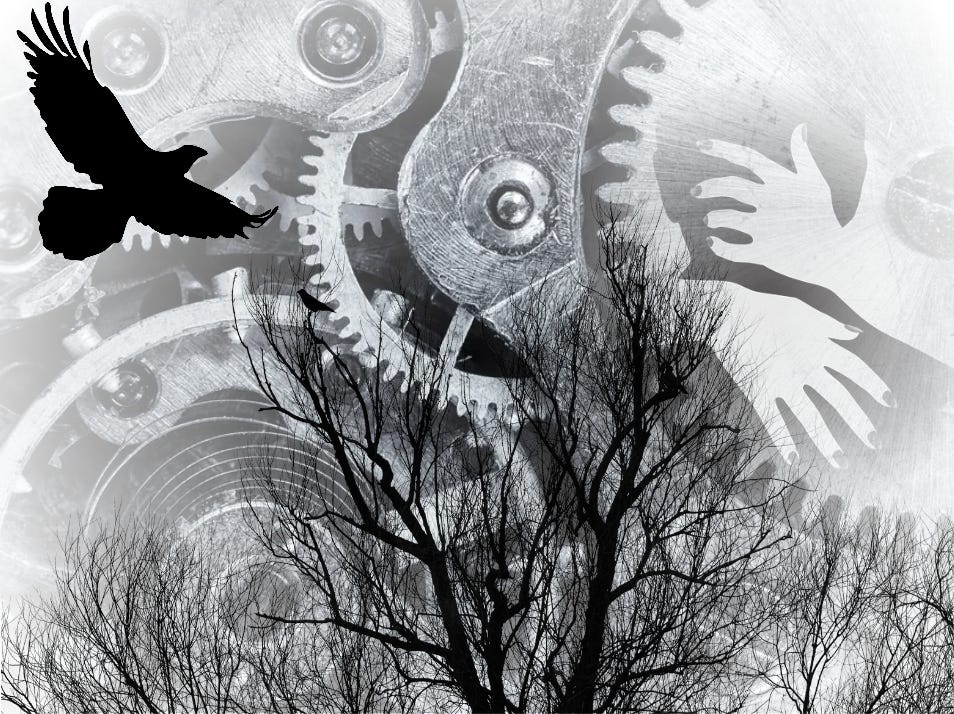
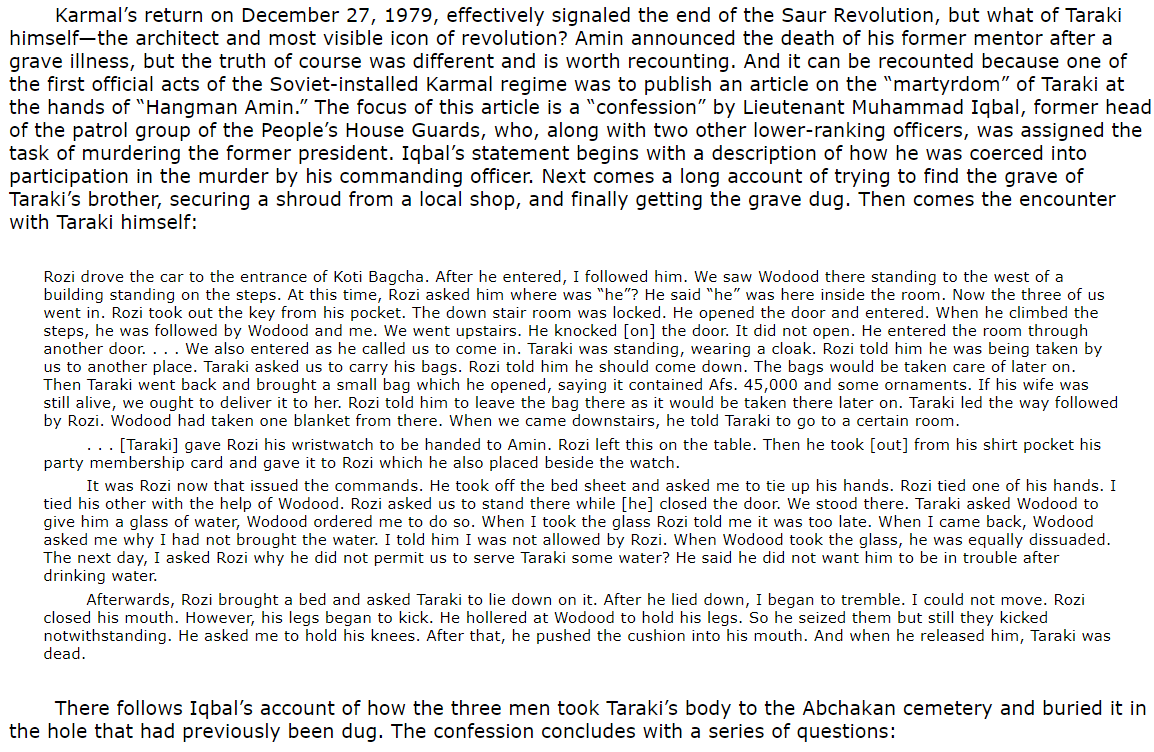
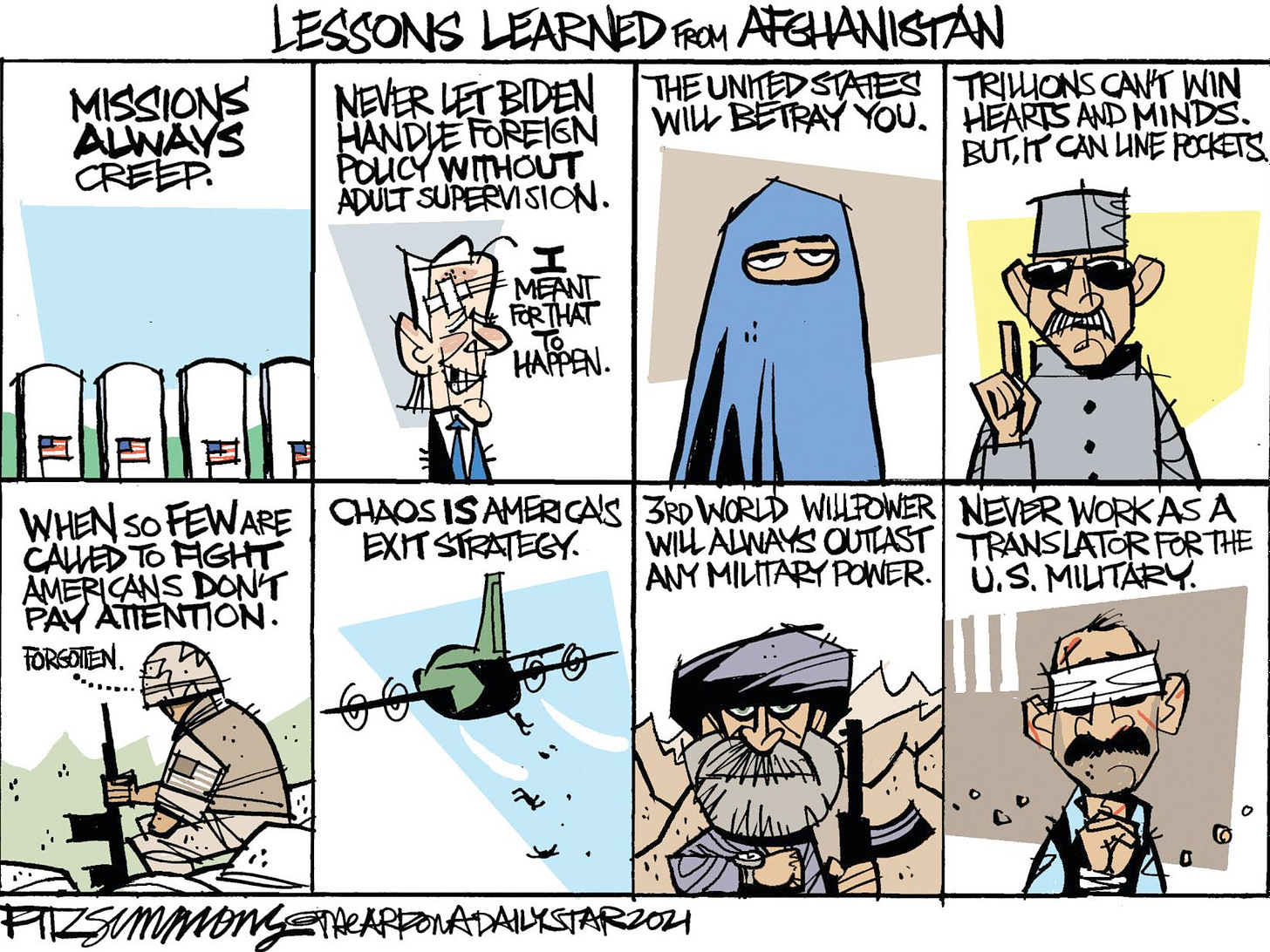
This was an amazing piece of work. 👏👏 Really well laid out, despite the huge amount of intricacies involved. Clarifies the goings on in Afghanistan to the extent that it can be done. I think the place simply does not afford you any further clarity.
Great work. My compliments... 😊